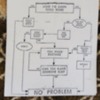Jumping in here with a long story and a request for knowledge.
The request, up front: is it possible or even probable that the clutch disc in my MG/Suby/VW stuck itself to the flywheel during the Season Of The Trailing Arm Bushing Replacement, and is that the most likely reason she would not go into gear at all when I was done?
Cuz that is now what I think happened, having replaced the clutch cable, welded new tubing inside the tunnel, adjusted it all seven times with no improvement, and pulled the engine to check if some throwout bearing-related things had cracked or flown apart (which I was sure must be the case but they had not).
What I never stopped to do is think hard about just what might be likely to go wrong on a car sitting for months on a lift, after having been driven there.
Throwout bearing spins easy and the clutch forks slide it in and out as they should.
I unbolted the pressure plate even though it looks fine, then tried to peel the friction disc off the flywheel. It wouldn't budge until I tapped it lightly with a hammer. It looks fine too. But always before the thing fell off whenever I detached the pressure plate.
So my theory now is that I had no good reason at all to replace any parts, weld on the tunnel or remove the engine. What I should have done (several months ago), is put the dang thing in gear and rocked it, or started it in gear. Or almost anything else than what I did.
And so now, having seen nothing amiss inside the bell housing, I feel like, before I put it all back together and try again, I ought to...just...ask around a bit. In case I'm missing something obvious.
Fire when ready.



 something that needs to framed and hung on the wall of any workshop
something that needs to framed and hung on the wall of any workshop 
